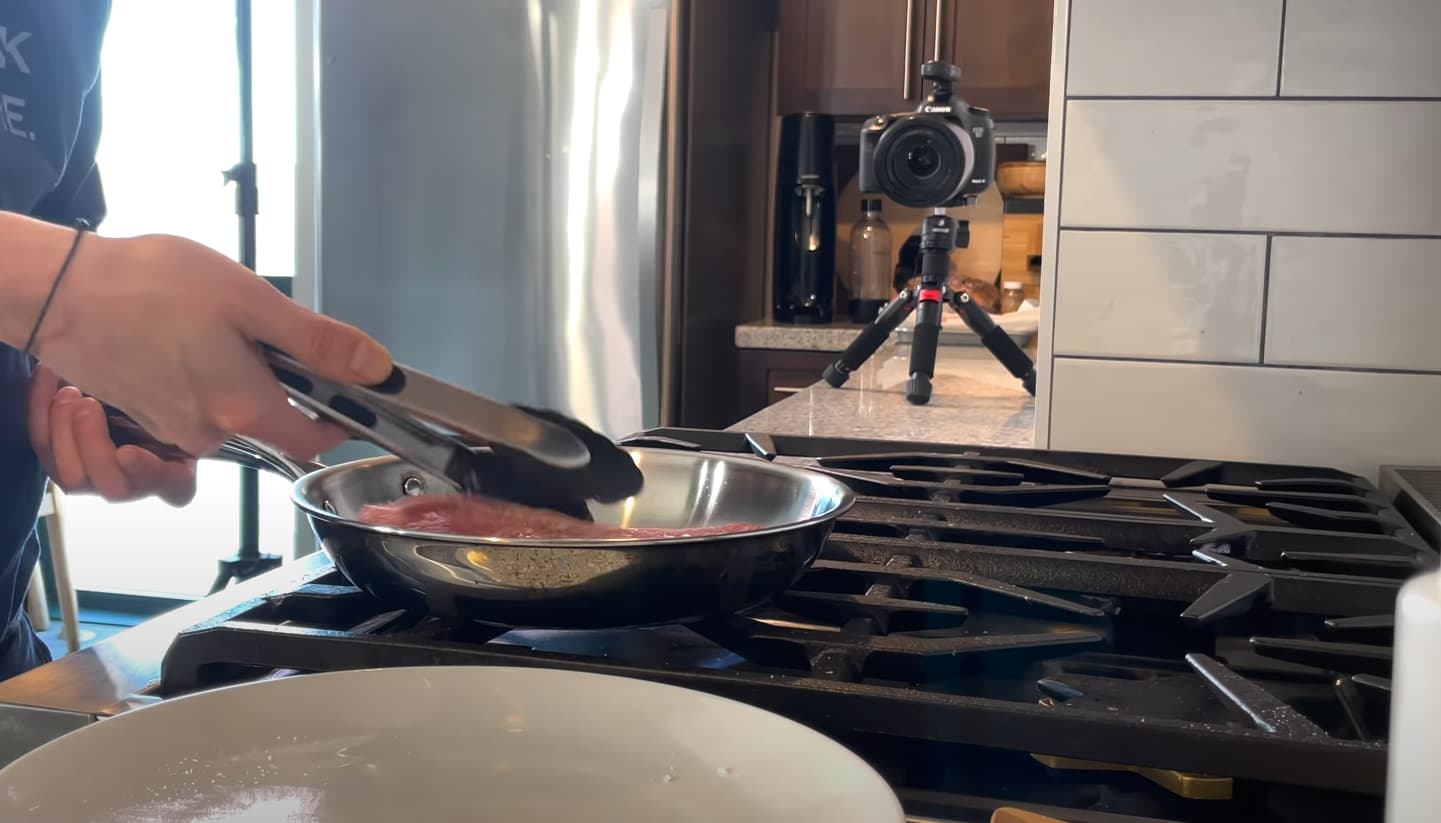When food is being cooked, there is a lot of heat generated in the kitchen because the meal goes through its consumption process. Furthermore, smoke contains a variety of noxious chemicals and pollutants that are bad for your health.
Moreover, when these particles enter your lungs, they can cause difficulty breathing and other respiratory problems. Lastly, the smell of smoke can linger in your home for days, making it difficult to enjoy your time indoors. If you’re looking for tips and ideas on how to keep your kitchen clean and fresh, check out the KitchenProfy blog, which offers a wealth of information on kitchen cleaning and organization.
Do you love to cook, but hate the way your kitchen smells afterward? If so, you’re not alone. Many people find that their kitchens get very smoky when they cook, and it can be a real challenge to get rid of the smell. In this blog post, we will explore some of the reasons why this happens and offer some solutions to help you keep your kitchen smelling fresh!
Smoke Point of Oil and Fat
The smoke point is the temperature at which an oil begins to produce a continuous stream of bubbles. The oil starts to break down and release harmful chemicals into the air. If you’re interested in learning more about home cooking and kitchen safety, be sure to check out HomeProfy, a blog dedicated to providing tips and advice for maintaining a safe and healthy home.
If you are using an oil with a low smoke point, it will start to smoke at a lower temperature and release more harmful chemicals into the air.
Some common cooking oils have very high smoke points, while others have relatively low smoke points.
For instance, grapeseed oil has a high smoke point of 420°F, while olive oil has a lower smoke point of 320°F.
Canola oil, peanut oil, and sesame oil all have smoke points around 400°F.
On the other hand, butter has a relatively low smoke point of 250°F and is more likely to cause your kitchen to fill up with smoke when it’s used for cooking.
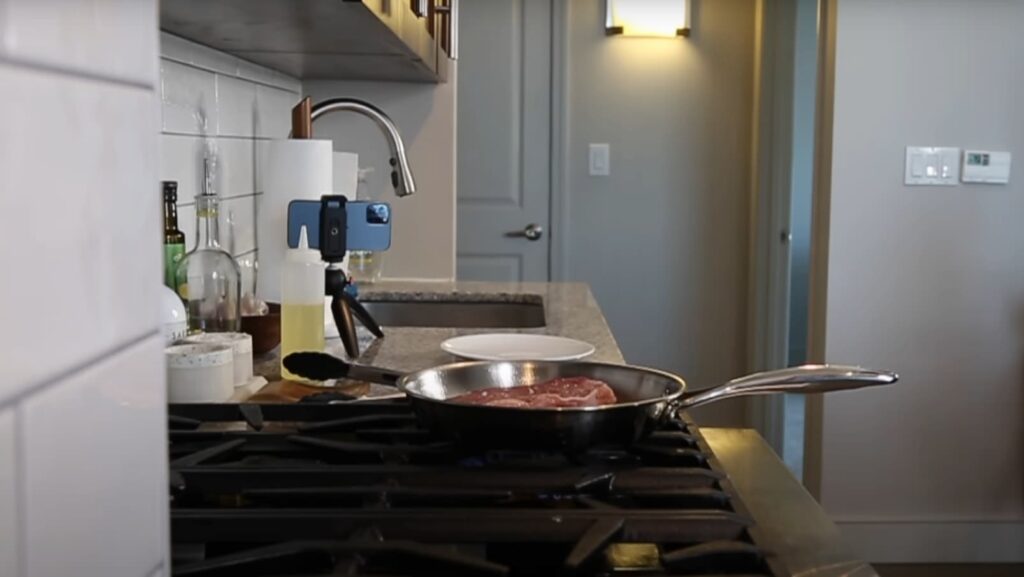
Cookware and Kitchen Smoke Sources
Pans
When cooking on non-stick surfaces, it’s important to use moderate heat. High heat can cause the release of toxic chemicals from the coating into the food. It can also cause the surface to break down, releasing particles into the air that can be breathed in. If you must cook on high heat, do so for only a short period of time.
Pans with uncoated surfaces are generally safer, but they can still produce smoke if they’re heated too quickly or to too high of a temperature.
Stainless steel and cast iron are two examples of pan materials that don’t have non-stick coatings.
If you’re using a pan with a non-stick surface, make sure the area is well ventilated. Open a window or turn on an exhaust fan to help remove smoke and fumes from the air.
Cooking methods that require less heat, such as braising or stewing, are less likely to produce smoke. If you’re frying foods, try using an oil with a high smoke point, such as canola oil.
Cast Iron Pans
Cast iron pans are popular for their even heat distribution and ability to hold heat well. However, they can also be a source of kitchen smoke.
If you’re using a cast iron pan, it’s important to season the pan before cooking. This helps create a non-stick surface and prevents the pan from rusting. Seasoning the pan also helps it withstand high temperatures without smoking.
If your cast iron pan does start to smoke, it’s likely because it wasn’t properly seasoned or because it was heated too quickly. To avoid this, preheat the pan slowly over low heat. Once it’s hot, increase the temperature gradually until you reach the desired cooking temperature.
Grills
Smoking food is a popular cooking method, but it can also be a source of kitchen smoke. Grills and smokers use wood or charcoal to produce smoke, which can be hazardous to your health if you’re not careful.
When using a grill or smoker, make sure the area is well-ventilated. Open a window or turn on an exhaust fan to help remove smoke and fumes from the air. If possible, cook outdoors to further reduce your exposure to smoke.
If you’re smoking food indoors, consider using an electric smoker. These devices don’t produce as much smoke as traditional grills and smokers, making them safer for indoor use.
Griddle Pans
Griddle pans are a type of cookware that has a flat surface for cooking. They’re often used to cook pancakes, eggs, and bacon. Like other types of pans, griddle pans can produce smoke if they’re heated too quickly or too high of a temperature.
To avoid smoking, preheat the pan slowly over low heat. Once it’s hot, increase the temperature gradually until you reach the desired cooking temperature.
Oven
Ovens can be a source of kitchen smoke, especially if you’re cooking at high temperatures. If possible, cook in a well-ventilated area, such as near an open window or under an exhaust fan. You might also want to consider using the oven’s venting system to help remove smoke and fumes from the air.
If you’re baking or roasting food, try to avoid opening the oven door too often. Every time you do, heat escapes, and smoke from the food can enter the kitchen. If you need to check on your food, take a peek through the oven’s window instead.
Air Fryer
Air fryers are a popular kitchen appliance for cooking fried foods. While they don’t produce as much smoke as traditional deep fryers, they can still create some smoke and fumes. If you’re using an air fryer, make sure the area is well ventilated. Open a window or turn on an exhaust fan to help remove smoke and fumes from the air.
To avoid smoking, cook at lower temperatures and don’t overcrowd the basket. Air needs to circulate around the food in order for it to cook properly. If the basket is too full, the food will take longer to cook and may start to smoke.
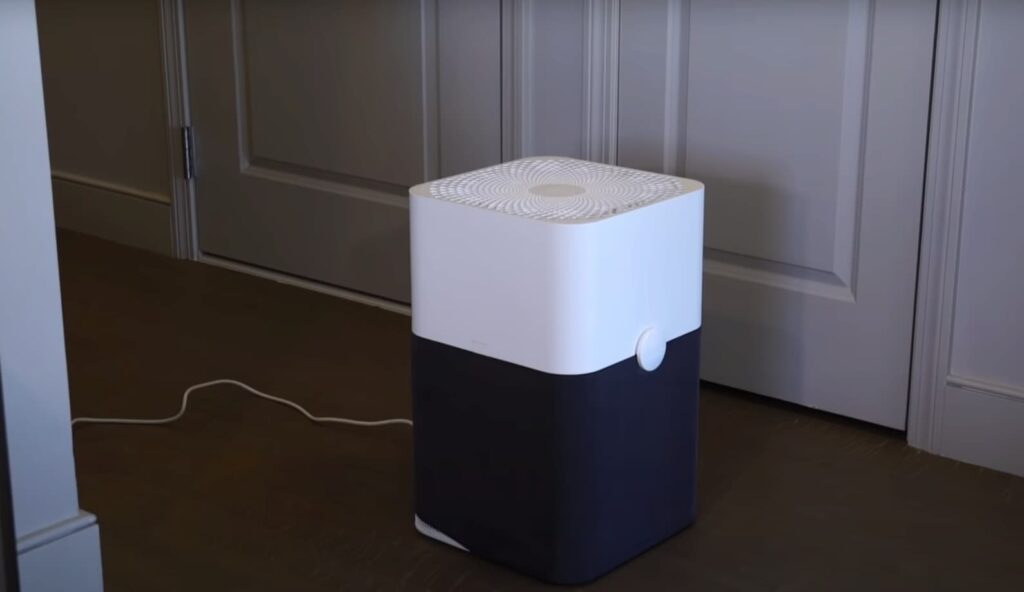
Food Smoke Sources
Steak
When cooking meat, it’s important to cook it all the way through to prevent bacteria from growing. However, overcooking meat can also cause it to release smoke. If you’re grilling or smoking meat, be sure to do so in a well-ventilated area.
Burgers
Like steak, burgers need to be cooked all the way through to prevent bacteria from growing. However, overcooking can also cause burgers to release smoke. If you’re grilling or smoking burgers, be sure to do so in a well-ventilated area.
Chicken
Chicken can also release smoke when overcooked. To avoid this, cook chicken until it is no longer pink in the middle. If you’re grilling or smoking chicken, be sure to do so in a well-ventilated area. Another common cause of smoke in the kitchen is grease fires. When cooking with oil, it’s important to use a high smoke point oil and to heat it slowly. If you see smoke starting to form, turn off the heat immediately and cover the pan until the smoke clears.
Bacon
Bacon is one of the most delicious and savory foods out there. However, it also has a tendency to make your kitchen incredibly smoky. If you’re wondering why your kitchen gets so smoky when you cook bacon, here’s what you need to know.
Bacon is essentially made up of two things: fat and protein. And when those two things are heated up, they release a lot of smoke. That’s why cooking bacon on the stovetop can often result in a smoky kitchen.
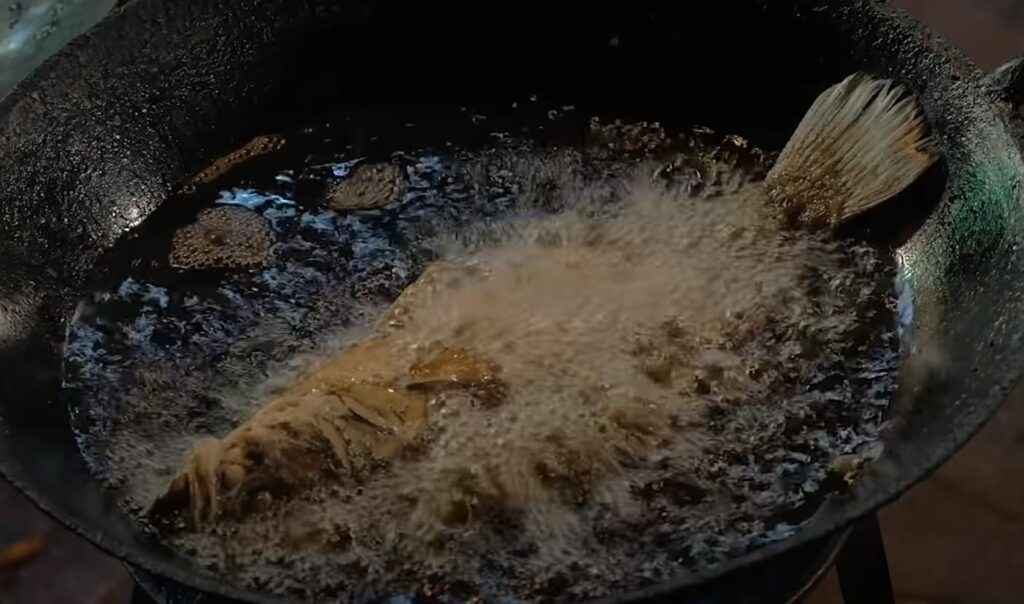
Major Causes of Kitchen Smoke Production
Food Residues
When cooking, food residues can accumulate on the surfaces of your stove, oven, and vent hood. These residues can be set ablaze by a stray spark or heat source, producing smoke. To prevent this from happening, make sure to clean your kitchen surfaces regularly.
Another common cause of kitchen smoke is grease build-up in your ventilation system. Over time, grease and oil can collect on the filters and ductwork of your range hood. When this happens, heat from cooking can cause the grease to smoke and fill your kitchen with fumes. To prevent this from happening, make sure to clean your range hood filters and ductwork regularly.
High Fat Food
One potential reason your kitchen gets smoky when you cook could be the types of food you’re cooking. If you’re cooking high-fat foods, the fat can start to smoke and produce a lot of smoke in your kitchen.
To avoid this, try cooking leaner meats and trimming any excess fat off before cooking. You can also cook at lower temperatures to help reduce the amount of smoke produced.
Using the Wrong Oil
The type of oil you use can also contribute to smoke in your kitchen. If you’re using an oil with a high smoke point, like olive oil, you’re more likely to see smoke. Oils with a lower smoke point, like vegetable oil, are less likely to cause smoking.
Another factor is how old your cooking oil is. As oil breaks down, it becomes more prone to smoking. So, if you’re using an old bottle of cooking oil, it’s more likely to cause smoking than a fresh bottle.
Finally, the temperature at which you’re cooking can also affect how much smoke your kitchen produces. If you’re cooking at a high temperature, the oil is more likely to break down and start smoking.
Lack of Attention
The number one reason why your kitchen gets smoky when you cook is that you’re not paying attention to what you’re doing. When you’re cooking, you need to be vigilant about keeping an eye on your food and making sure that it doesn’t burn or overcook. If you’re not paying attention, then it’s very easy for things to go wrong and for your kitchen to fill up with smoke.
Faulty Appliances
Faulty appliances are one of the most common causes of smoky kitchens. If your stovetop is old or in disrepair, it can cause smoke to build up and fill the room. The same goes for your oven and range hood. If any of these appliances aren’t working properly, they can release smoke into your kitchen.
Lack of Seasoning
One common reason your food may be smoking is a lack of seasoning. Seasoning helps to create a barrier between the food and the pan, allowing the food to cook without sticking, and also preventing it from drying out. When you don’t season your food properly, it can cause the dish to smoke excessively.
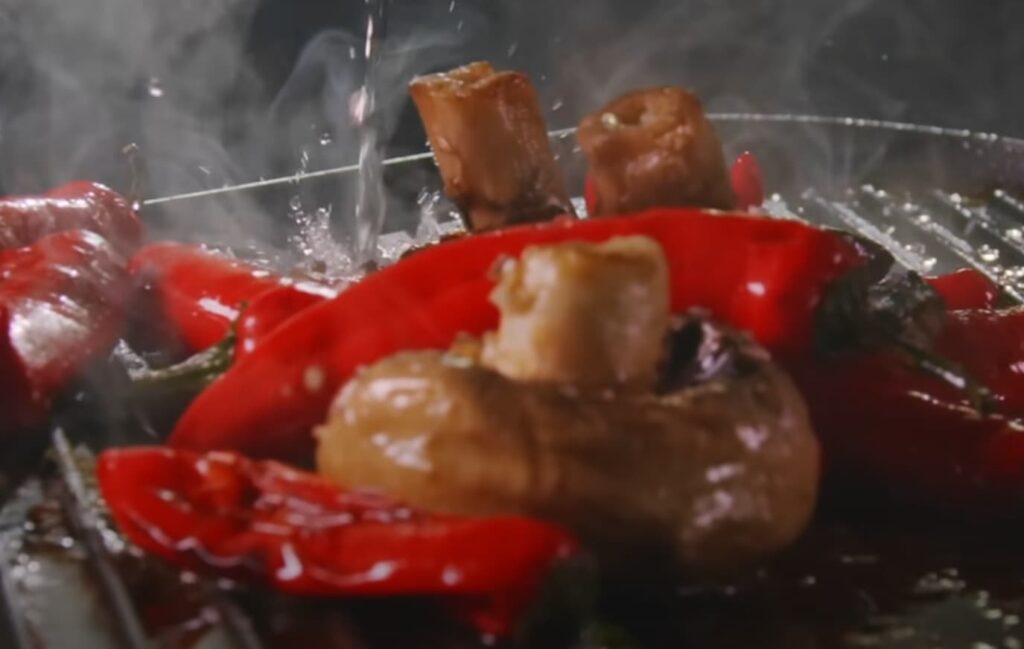
How to Reduce Smoke While Cooking Indoors
Understand Your Kitchen Appliances
The Range
A difference you may not notice if you move apartments regularly is that gas ranges can have very different max BTU ratings. Additionally, most vents are attached to microwaves and dreadful, but some come with carbon filters. Some intakes are more powerful than others, but the equation for proper uptake is often ignored by apartment developers. The average 4-burner stove has a BTU rating of around 7,000.
The Vent
Most apartment kitchens have vents that go up and out the roof. The problem is that many of these are not very powerful. If you live in an older building, your range hood might only be 60 CFM (cubic feet per minute). Newer ones tend to be around 300 CFM. This means that it takes a long time for the smoke to actually leave your kitchen. And if you’re cooking on high heat, you can forget about any chance of the vent keeping up.
A range hood needs at least 100 CFM for every 10,000 BTU of your cooktop to operate. A 100,000 BTU stove requires a 1000 CFM range hood, for example. For electric stoves, multiply the stove’s width by ten. So, for a 42-inch electric stove, you’ll need a range hood with at least 420 CFGMs (CFM = cubic feet per minute).
Change Your Cooking Method
Put A Lid On It
If you’re sautéing, frying, or browning foods on the stovetop, smoke is bound to happen. One way to prevent this is to cook with a lid on your pan. This will help contain the smoke and allow it to dissipate more quickly.
Another option is to use an exhaust fan. If your stove doesn’t have one built-in, you can purchase a portable unit that will do the trick. Just be sure to place it near the source of the smoke so it can effectively remove any fumes from the air.
Put It In The Oven
Smoke can also be caused by cooking foods in the oven. This is especially true if you’re broiling or grilling meats. To avoid this, you can try cooking your food at a lower temperature for a longer period of time. This will help to prevent any smoke from developing.
You can also try using an oven hood or exhaust fan to remove any smoke that does occur. Just be sure to turn it on before you start cooking and leave it running until the smoke has cleared.
Use a Grill Pan
If you love the taste of grilled food but don’t want to deal with the smoke, try using a grill pan. These pans have ridges that mimic the look and taste of grilled food without all of the fuss. Just be sure to cook on a lower heat setting so the pan doesn’t get too hot and cause any smoke.
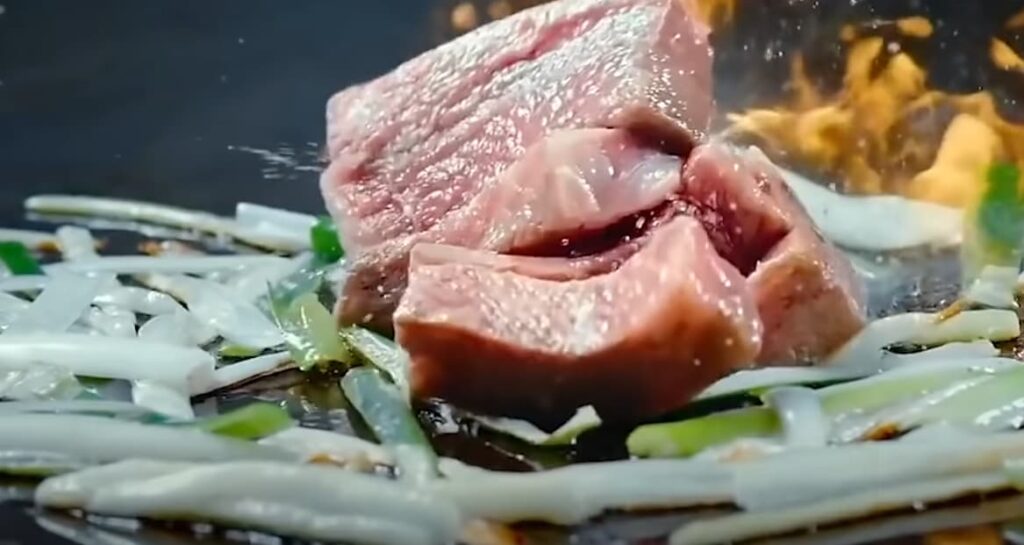
FAQ
How do you sear without smoking the house?
Here are a few tips:
- Use an exhaust fan. This will help to remove some of the smoke from the room;
- Start with a clean pan. A dirty pan can cause smoke because of the build-up of oils and food particles;
- Don’t overheat the oil. If the oil is too hot, it will create more smoke;
- Add food to the pan in batches. Adding too much food to the pan at once can also cause smoke;
- Move the pan around. This will help to distribute the heat and prevent hotspots that can cause burning and smoking;
Why does my nonstick pan smoke?
The smoke you see coming off your nonstick skillet is actually just water vapor. When the pan gets hot enough, the water molecules in the cooking oil start to break down and turn into gas. That’s why you’ll see a lot of smoke when you first start cooking with a nonstick pan, but it should dissipate after a few minutes.
If your pan is still smoking after it’s had a chance to heat up, that’s usually a sign that it’s too hot. Turn down the heat and give it a few more minutes to adjust. You may also want to add a little bit more oil to help keep things from sticking and burning.
Is the smoke from cooking toxic?
The short answer is no, smoke from cooking is not toxic. However, it can be a nuisance and cause problems for people with respiratory conditions.
There are two main types of smoke: primary and secondary. Primary smoke is the smoke that comes directly from the food that’s being cooked. Secondary smoke is the smoke that’s created when fat or juices from the food hit the hot surface of the grill or smoker.
Both types of smoke can be irritating, but secondary smoke is generally more problematic because it’s made up of smaller particles that are easier to inhale deeply into your lungs. These particles can also adhere to surfaces and clothing, which can create lingering odors.
How do I get rid of cooking smells in my apartment?
A few things you can do to help get rid of cooking smells in your apartment:
- One is to make sure that you have good ventilation in your kitchen. If you have a range hood, use it when cooking. You can also open windows or doors to let fresh air in while you’re cooking;
- Another thing that can help is to cook at lower temperatures. This will help to prevent smoke from building up in your kitchen;
- Finally, if you have an exhaust fan, turn it on after cooking to help remove any remaining smoke and odors from your kitchen;
